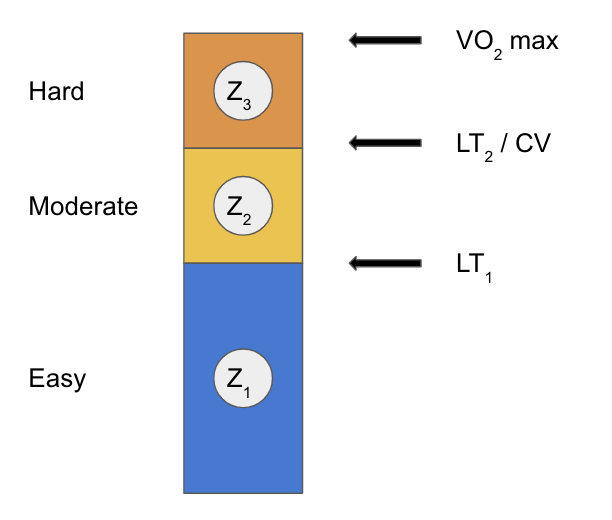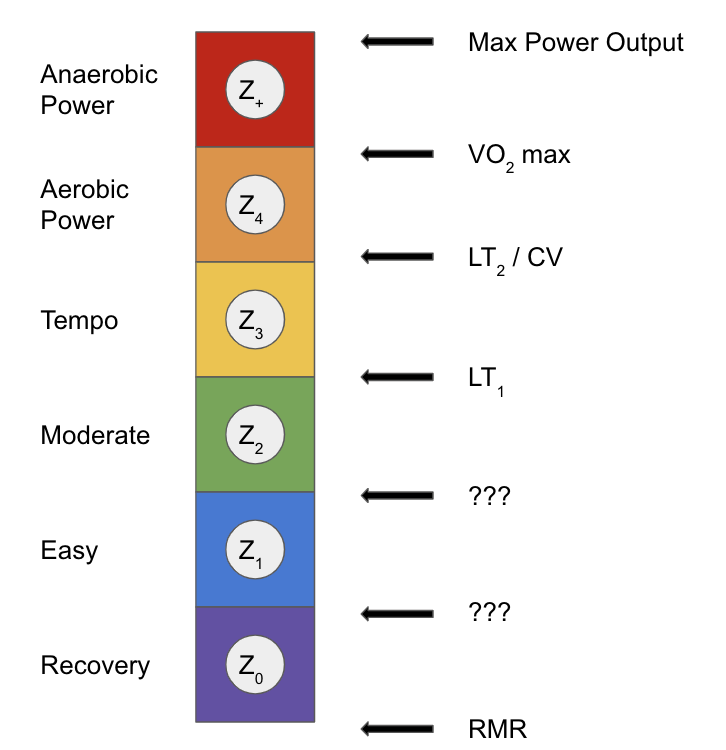How I Think about Training Zones and Intensities
I have noticed that a lot of coaches and athletes use a lot of different terms and definitions to describe training intensity. And with that having a conversation about training can be a little difficult since we are speaking two different languages in a way. So today I just wanted to clarify how I think and talk about zones.
There is a fifth dimension, beyond that which is known to athletes. It is a dimension as vast as “Let’s Run” message boards and as controversial as weightlifting for endurance athletes. It is the middle ground between too easy and too hard, between science and superstition, and it lies between the pit of exercise physiologist’s fears and the summit of their knowledge. This is the dimension of intensities. It is an area which we call The Training Zones.
That’s right, today I am going to be stirring the pot and talking about how I, as a coach and athlete, think about training zones and intensities. I will start by acknowledging that there are many more qualified exercise physiologists and coaches who have talked endlessly about this topic and, if you want to learn more about what the experts make of zones, check out Dr. Stephen Seiler’s youtube channel linked here or check out Dr. Philip Skiba’s book “Scientific Training for Endurance Athletes” linked here. Both the Seiler’s and Skiba’s work have heavily influenced my knowledge of training zones, however not everything I am going to talk about here is going to completely coincide with the models they use – because I am just a rebel like that.
Now the purpose of this post is not to say the current models are wrong, but to say, I think that they don’t capture the full picture of training zones to the degree athlete’s and coaches need to keep in mind. At the end of the day, there is no such thing as a perfect model. But for ease of communication with my athlete’s, today I want to talk about my own semi-unique model I use. Now with the disclaimers out of the way, let’s dive in. May Dr. Per-Olof Åstrand have mercy on my soul.
The Three Zone Model

When talking about contemporary zone models, we are typically talking about the three zone model which is currently being used by most exercise physiologists and savvy coaches alike. Considering the three zone model serves as the foundation for how I like to think about training intensity, I figure giving a quick summary of this model is a good place to start. The basic concept here is training intensities are divided up by your lactate thresholds, LT1 and LT2.
I am going to generalize some things here for the sake of time, but one basic thing you need to know to understand this model is that as metabolic rate increases, lactate production increases. While lactate itself does not cause muscle failure, its appearance in the blood is correlated muscle failure. Zone 1 (Z1) includes anything underneath LT1 (kinda… but more on that in a bit). Below LT1, your metabolic rate is low enough that your muscles are able to buffer lactate and utilize it as fuel, so you don’t see much lactate showing up in the blood stream. Hence the low blood lactate levels. This is considered easy training and the purpose of training in this zone is to improve your aerobic base.
Once you move above LT1 you enter Zone 2 (Z2). In this zone, your muscles are no longer able to keep up with lactate production, so it begins to leak out into the blood stream. However, lactate levels in this zone are buffered by other organs in the body (like the liver, heart, and brain). This zone is considered moderate training and the purpose of training in this zone is to improve your lactate thresholds and lactate buffering systems.
Above LT2, your body is no longer able to keep up with lactate production and blood lactate levels will exponentially increase. This is zone 3 on a three zone model. This zone is considered hard training (aka see the face of God zone) and the purpose of this zone is to maximize your body’s ability to put out power aerobically. Which basically means raising your VO2 max.
Problems with the Three Zone Model
Now I understand why this model is popular these days. It is directly tied to measurable physiological markers. However, I think there are some key short comings to using this model. Number one is VO2 max is not your power output ceiling. Anyone who has ever gotten their VO2 max tested knows that their velocity at VO2 max is slower than their max speed. Why is this? Whenever we are measuring your ventilatory system (via HR or VO2) we are only measuring your aerobic system. But we miss measuring your anaerobic system with these measurements. Now for endurance athletes, the anaerobic system isn’t the most important thing, but we can’t ignore something that is very much there.
On the other side of the spectrum, we aren’t given much context on where the three zone model starts since the lower end of Zone 1 isn’t defined. This is actually a hot topic among athletes. Basically, the three zone model does not define how easy is too easy. The line here is pretty murky, but we need to define what is the bare minimum effort level needed to elicit a significant fitness adaptation and acknowledge that there is a zone below Z1.
My last qualm with this model is how broad Z1 is. Now I’ll be honest for this one, my opinion here is more based off a hunch and gut feeling than direct scientific evidence. Anecdotally, I and other experienced athletes I have worked with, can perceive a difference between the low end and high end of Z1. What causes this shift in perceived effort level and what justifies me making an extra zone to account for it? I am not sure, but I theorize it has something to do with a shift in ratios of lipid metabolism to carbohydrate metabolism. This zone is basically the physiological equivalent of the Bermuda Triangle. We don’t really know what’s going on here, but something is afoot! Regardless of if you buy into my conspiracies, most research and coaches suggest we shouldn’t be spending all of our easy training running at the upper end of Z1, so I think it is important to give some definition of what that upper end is.
So, while I think the three zone model is awesome and probably more scientifically sound, I like to use a 6 zone model. Sheesh! I am a thousand words in I am just now getting into my model! Thank you for sticking around.
My Training Zone Model

Z+: Anaerobic Power
At the very top of my model is your anaerobic power zone which includes any intensity above your VO2 max. Its ceiling is your max power output you can generate. I denote it as Z+ because it is a zone outside of your aerobic system unlike all your other zones, which means we can’t use heart rate or respiratory rate to gauge this effort. Think of this intensity as a speed in which your muscles will max out before your aerobic system does. While not the most important metabolic zone to train for endurance sports, we can get some great neuromotor and muscular training in this zone which will help improve speed across all the lower zones. An example of a workout in this zone would be hill strides.
Z4: Aerobic Power
Next up we have the aerobic power zone which includes anything above LT2 or Critical Velocity (CV) and up to your VO2max. In terms of effort this includes anything in between your 10k effort to your 1mi effort. This zone is where your aerobic system reaches its limits and maxes out. Think of this as your aerobic ceiling. In this zone, breath rate should be very high and you shouldn’t be able to talk much. We train in this zone because the higher your VO2 max is the more room we have to raise the zones below. An example workout in this zone would be 5x3min @5k effort.
Z3: Tempo
In between LT1 and LT2 sits your tempo zone. In terms of effort, it includes anything in between your half /full marathon effort to your 10k effort. Like Z2 in the three zone model, this is where your body maximizes it’s ability to buffer lactate with the goal of improving your speed endurance. At this effort level your breath rate will be high, but you should still be able to get two to three words out if pressed. An example of a tempo workout would be 20min @ 1hr effort.
Z2: Moderate
Now the definitions are going to get tricky. In terms of effort, this zone includes anything in-between below your half / full marathon effort to your 50k effort. Main goal here is to improve your aerobic threshold and your muscular endurance. At this effort level, your breath rate will be higher than easy pace, but you should still be able to say 1-2 sentences occasionally. An example of a tempo workout would be 14mi easy/mod (4mi easy, 1hr moderate, easy cool down to hit mileage).
Z1: Easy
In terms of effort, we are looking for anything below 50k effort but above a jog or a brisk walk. It is almost impossible to run too slow to receive the aerobic benefits we are targeting here, so as long as you run at a speed or hike at a speed equivalent to an effort level you would use to jog on flat ground you should be good. I like to use the talk test to determine your effort level here. You should be able to hold a conversation at this effort, but it should be difficult to sing.
Z0: Recovery
We get a little solid ground here since we can define the bottom end of this zone as your resting metabolic rate and the top end would be a brisk walk on level ground. It’s wildly debated on how important this zone is to aerobic adaptation and I have already been way to controversial today to give definitive opinions on this at this moment. But I will say that no matter what this is an important zone to consider. Adaptation occurs during periods of rest, not during periods of activity. So, this is the zone that is going to allow you to adapt to everything we just talked about! An example of a recovery workout would be a chill walk or bike.
So, there are all my zones! Even if this isn’t the most concrete way to think about training, I hope you find these zones as useful for gauging, writing, and thinking about training as much as I do!
In future articles, I will be doing a deeper dive on each zone I use. I will discuss when to put zones in training, the exact physiological adaptations created by them, and how to structure specific workouts for each zone. That is to say, so long as this article doesn’t get dunked on by every physiologist and their mom beforehand.
